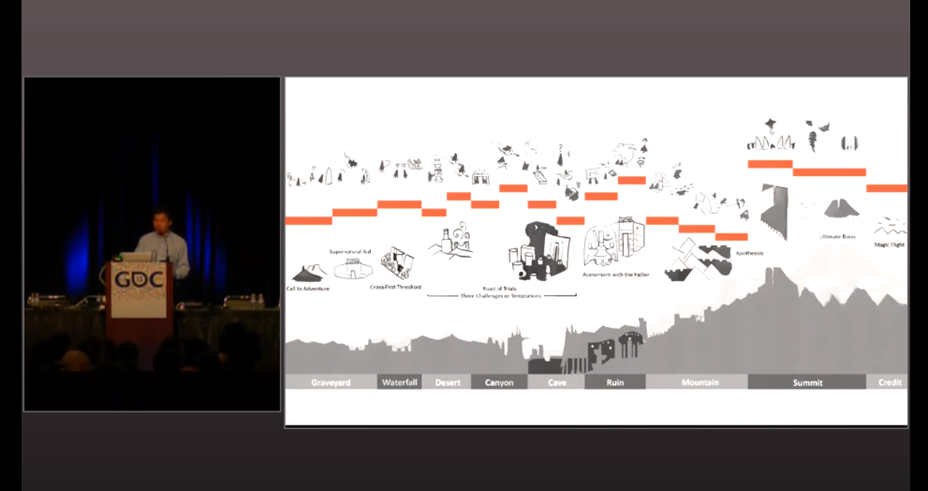People often discuss “story” as a broad term that means many things. As Narrative Designers, we can only be successful collaborators if we speak the same language as other teams and agree on the meaning of words and concepts. I’ve encountered at least three usages of the word “story” that are three very different things.
- PLOT
- What happens in a story
- The events
- THEME
- What the story is about
- What truth about the world are we revealing?
- How do the events impact the characters?
- NARRATIVE
- How the story is structured and unfolds
- Between the campaign, the secondary quests unlock, the collectibles in the world, the extended lore, comic books, novel, short stories, etc.
We can’t ignore any of these layers, when expertly iced and layered together, they find balance and create the best experience. It’s on us, Narrative Designers to not only bake the cake but also ice each layer individually and altogether. After our work is done, the players eat and enjoy it. The player story is dependent on how each player eats the cake. It’s our responsibility to present the narrative elements in a way that ensures that however a player eats the cake, it will be delicious.
The way players consume the narrative experience is the player story.
The Player Story
The cake is the Narrative that we’ve designed. The player story is how each player will eat the cake. No matter how you are designing the narrative experience, the player will experience it moment after moment, in a linear way, at their own pace. I have always found it challenging to explain to people why this moment works at that time but at another time, it doesn’t. Saying “it doesn’t feel right” isn’t enough. Beyond what feels right, there is a structure.
All stories have a beginning, a middle and an end. That’s even what we learn first when writing a story, the three-act structure.

Knowing that structure, though, never actually helped me write. In fact, it made me feel incompetent when I struggled to figure out just what the second act needed to be. I’ve always felt that in a real emotional journey, a meaningful story you need more peaks and valleys than just three acts offer.
While we should not be following the Hero’s Journey to the letter, we learn quite a bit from it and many other story structure theories. Here, we see story split into more than three acts. Some with seven, 12, 17 or even 22 parts. They are all different and yet say the same thing: There is a common structure to all stories. Taking that knowledge, I’ve simplified those theories and applied them to video games.

As you can see we don’t have three beats, but 17, to consider. To read a more detailed breakdown of this model, visit the pages on the Emotional Journey starting with this page. Those 17 beats are a guide to use when developing an emotional journey. When we talk about structure, it’s natural to be concerned about following a template or one size fits all approach. As humans, our physiology and psychology, work in particular way and there are universal emotional triggers. Understanding this psychology serves as a tool to gain a deeper understanding of how emotions work. With that understanding, we can reach myriad emotions all while working within established narrative structure. Another way to look at it is through an intensity curve:

This curve should look familiar to any designer. For example, here is the interest curve from the book The Art of Game Design: A Book of Lenses from Jesse Schell.

These two curves are very similar because they both represent the same thing. Narrative and game design have the same experiential goal. So if we have all this theory about narrative structure that split the 3 acts into 17 beats, Couldn’t we apply these narrative theories to game design too? Jenova Chen, the creative director of JOURNEY did just that when developing the game. He took Joseph Campbell’s work and translated it into the game design of JOURNEY, focusing on not the story but the player experience. He went into detail about this approach in a 2013 GDC talk, discussing how he took that intensity curve and translated it into the environment and in-game mechanics.
It created tremendously positive responses from players. With a narrative structure as its foundation, JOURNEY takes the player on an emotional journey.
In gaming, it is never only about the game; it is about the player. The real player story goes through that structure. Whether it’s a campaign, a quest or a puzzle game, the real player story follows this structure. With five minutes of narrative, or five hours or even a full year, the more the player experience follows this structure, the more emotional the player experience will be and the stronger the impact on the player will be.
Linear crafted activity
When creating a game with a linear flow, like a linear campaign or missions, think about those peaks and valleys.

Free Exploration
When creating an open-world game, think about how the player will explore it and how the structure can guide those moments. Look at how Zelda, GTA or Red Dead guide the player through the exploration of the environment. Each region has its own unique mood and intensity that maps to that structure.

Open-ended Sandbox Game Mode
And finally, when creating an open-ended sandbox game like Counter-strike, DOTA, or PUBG, think about what kind of game mechanics can push the player in experiencing this emotional journey. Even for a world as open as PUBG, the circles limiting the play space during the game is the mechanism that creates the peaks and valleys that provide a real emotional ride.

